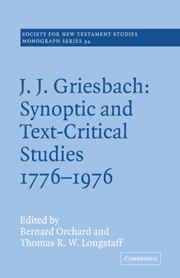Book contents
- Frontmatter
- Contents
- Portrait of J. J. Griesbach
- Copy of Colloquium announcement
- List of participants and selected observers
- Preface
- Abbreviations
- 1 The genesis of the Colloquium
- 2 Johann Jakob Griesbach: his life, work and times
- 3 The Gospel synopsis from 1776 to the present day
- 4 Griesbach's answer to the Synoptic Question
- 5 Commentatio qua Marci Evangelium totum e Matthaei et Lucae commentariis decerptum esse monstratur
- 6 A demonstration that Mark was written after Matthew and Luke
- 7 Griesbach and the development of text criticism
- 8 Modern text criticism and the Synoptic Problem
- 9 At the Colloquium's conclusion
- 10 The Griesbach Hypothesis: a bibliography
- Notes
- Appendix
- Index
6 - A demonstration that Mark was written after Matthew and Luke
Published online by Cambridge University Press: 23 December 2009
- Frontmatter
- Contents
- Portrait of J. J. Griesbach
- Copy of Colloquium announcement
- List of participants and selected observers
- Preface
- Abbreviations
- 1 The genesis of the Colloquium
- 2 Johann Jakob Griesbach: his life, work and times
- 3 The Gospel synopsis from 1776 to the present day
- 4 Griesbach's answer to the Synoptic Question
- 5 Commentatio qua Marci Evangelium totum e Matthaei et Lucae commentariis decerptum esse monstratur
- 6 A demonstration that Mark was written after Matthew and Luke
- 7 Griesbach and the development of text criticism
- 8 Modern text criticism and the Synoptic Problem
- 9 At the Colloquium's conclusion
- 10 The Griesbach Hypothesis: a bibliography
- Notes
- Appendix
- Index
Summary
[Translator's note: This is the first rendering into the English language of a Latin text which holds many subtleties of argumentation, but every endeavour has been made to remain faithful to the thought of the original. The translator has however deemed it necessary to introduce a certain number of sub-headings and also occasionally to insert a word to avoid ambiguity; all these additions are indicated by enclosure in square brackets. J. B. 0.]
The Dissertation of J. J. Griesbach, Doctor of Theology and Principal Professor in the University of Jena, in which he demonstrates that the entire Gospel of Mark has been extracted from the Gospels of Matthew and Luke, written in the name of the University of Jena (1789–1790), now revised and furnished with many additions.
[Introduction]
It is above all important to know the sources from which historical writers have drawn the things which they have put into their own commentaries, in order to interpret correctly their books, to evaluate justly the trustworthiness of the authors, and to perceive and judge skilfully the true nature of the events that they have recorded. Hence, on an earlier occasion, we made a Dissertation about the sources from which the narratives of the Evangelists on Christ's Resurrection were derived.
- Type
- Chapter
- Information
- J. J. Griesbach: Synoptic and Text - Critical Studies 1776–1976 , pp. 103 - 135Publisher: Cambridge University PressPrint publication year: 1979
- 1
- Cited by



